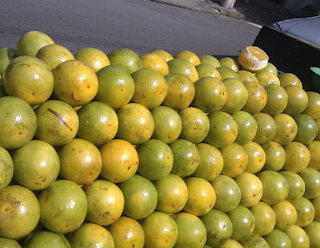A London-based project dubbed OPEC (Orange Peel Exploitation Company) aims to make biofuel from the waste from the more than 10 million tons of oranges that Brazil squeezes into juice each year. It is the latest of many research projects aiming cut CO2 emissions.
This year, Brazil produced 15 million tons of oranges. About 86% of those oranges were then turned into fresh orange juice. Imagine, then, the number of orange peels thrown away in Brazil.
The orange-peel abundance in Brazil is enough to attract attention from the British chemist James Clark, a professor at the Center for Green Chemistry at the University of York. Clark wowed the most recent British Science Festival by presenting a technique for converting orange peels into biofuel, using microwave energy. It is one of many research projects in the Old Continent attempting to develop biofuel in order to help reduce CO2 emissions.
Clark’s technology is part of a project called OPEC (Orange Peel Exploitation Company). The process consists of crushing the orange peels, putting them in a microwave that resembles a giant home oven, and activating the cellulose and other components with the microwaves. “The orange peel has an interesting chemical composition that makes it very easy to convert into fuel,” says Clark.
The European Union has contributed six million euros to the project. The Carbon Trust, a major British company that specializes in the renewal of carbon-based energy, and the University of São Paulo, have also collaborated. Now Clark and his group are working with a test processing unit, which allows them to process 30 kilos of orange peel (or other citrus peel) per hour.
This year, Brazil produced 15 million tons of oranges. About 86% of those oranges were then turned into fresh orange juice. Imagine, then, the number of orange peels thrown away in Brazil.
The orange-peel abundance in Brazil is enough to attract attention from the British chemist James Clark, a professor at the Center for Green Chemistry at the University of York. Clark wowed the most recent British Science Festival by presenting a technique for converting orange peels into biofuel, using microwave energy. It is one of many research projects in the Old Continent attempting to develop biofuel in order to help reduce CO2 emissions.
Clark’s technology is part of a project called OPEC (Orange Peel Exploitation Company). The process consists of crushing the orange peels, putting them in a microwave that resembles a giant home oven, and activating the cellulose and other components with the microwaves. “The orange peel has an interesting chemical composition that makes it very easy to convert into fuel,” says Clark.
The European Union has contributed six million euros to the project. The Carbon Trust, a major British company that specializes in the renewal of carbon-based energy, and the University of São Paulo, have also collaborated. Now Clark and his group are working with a test processing unit, which allows them to process 30 kilos of orange peel (or other citrus peel) per hour.

.png)


0 comments:
Post a Comment
Grace A Comment!